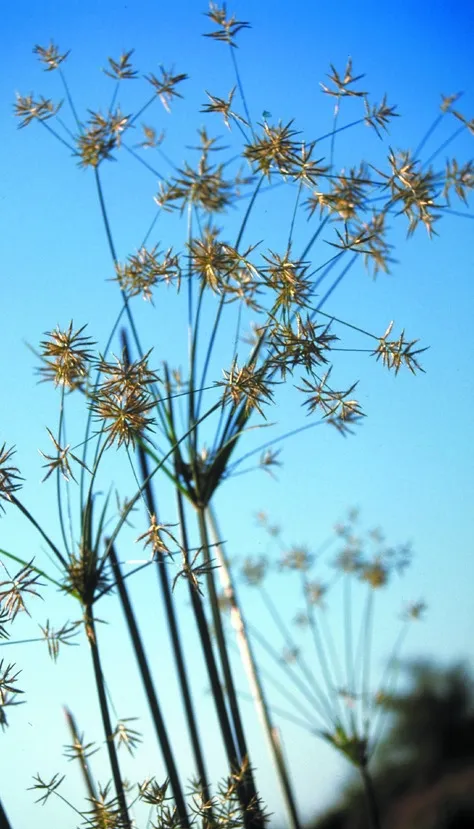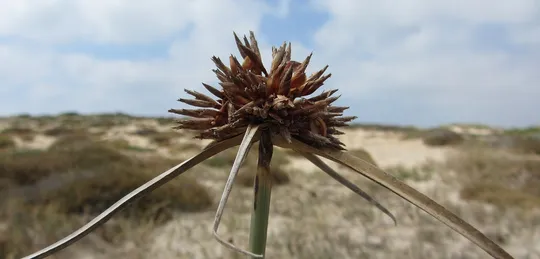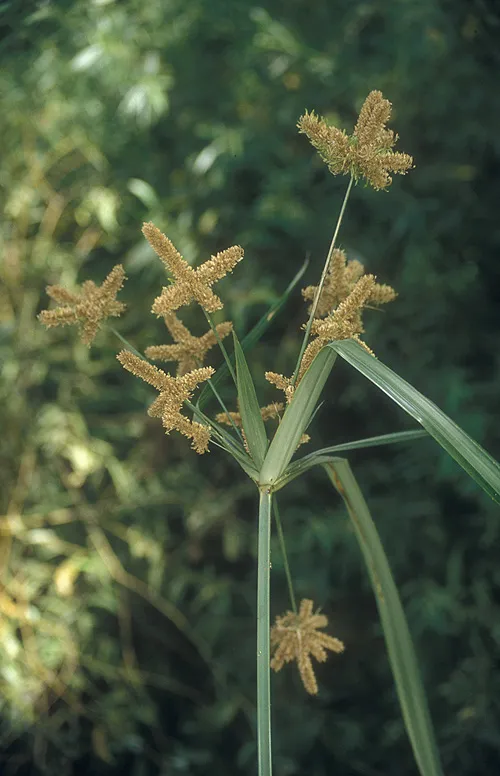Cyperus nitidus
Cyperus nitidus, which formerly grew in five regions in Israel, is now extinct in most of them: in the Philistine Plain it was collected only from Wadi Rubin in 1926 (Wadi Sorek). In the Sharon it was known from four sites (Batih pond, Hadera Forest, Ya'ar Pond, and the sources of the Yarkon (collections until the 1940s), and is definitely extinct from them. A detailed survey conducted in 1994 did not find any plants. A single C. nitidus individual was found near the Ayalon Highway in 1987 but has not been seen since. One sample was collected in the Kinarot Valley near Kibbutz Ma'agan in 1963. In the Hula Valley it was collected in 1941 at En T'eo and has since become extinct. In Ahu Gonen C. nitidus plants were sampled and identified in 1979-1982, but the identification may be mistaken. This is probably the only site that still has a living population of C. nitidus. There is a record of the species from the Zavitan Stream canyon in the Golan from 1998, but it has to be verified.
Stream banks and slow flowing clear water channels.
For the genus Cyperus see Cyperus corymbosus.
Cyperus species are very difficult to identify and require knowledge of the variability of the diagnostic signs of wild populations. C. nitidus is a species of medium height (on average 50 cm) which distinguishes it from the group of tall Cyperus species, such as C. dives and C. longus, whose height generally exceeds 120 cm and from the group of short Cyperus, such as C. fuscus, C. michelianus and C. laevigatus, whose average height is 15-20 cm. The problem is that height is a very variable character, which is dependent on water availability, and therefore the species description notes its height as “30-90", which is considered a large range. It can be distinguished from other Cyperus species of by the shape of its inflorescence, which is elongated rather than spherical, and by the racemes of the spikelet cluster in each umbel ray, which is sparse, and not dense as in C. alopecuroides.
• Only two of the 10 sites that were known sixty years ago remain.
• The two surviving sites since the 1980s are located in nature reserves – Ahu Gonen and the Zavitan Stream Nature Reserve.
• Cyperus nitidus may be extinct: it was last observed in Ahu Gonen in 1982, and the observation made in Zavitan Stream needs to be verified.
• The species is extremely vulnerable to grazing and is a favorite with cattle.
• This is a tropical peripheral species, which does not grow in southern Israel, or in Sinai or Egypt. This is its only site in the Middle East. There is a large geographical disjunction of 2,000 km between the sites in Israel and the populations in the Sudan.
A systematic study field survey should be conducted in the Hula-Bet Tsayda Basin. All the sites from which Cyperus nitidus was once known should be checked and attempts made to find new sites. This study should be linked to the detection and identification of other Cyperus species (some of which are “red” and very rare) from the same habitats. Only a thorough systematic investigation will allow us to determine how many sites exist now and how they should be prioritized for conservation. Clearly, the rehabilitation of Ahu Gonen is a first priority: we must expose the flow channels and ensure a sufficient flow of pure water as well as controlled grazing.
Cyperus nitidus grows only in tropical Africa: Sudan, Tanzania, Congo, Angola and Botswana. Israel is the only country in which the species digressed from Africa and penetrated to Asia and farther north. It is not found in either Egypt or Sinai.
Cyperus nitidus is a perennial tropical plant that grows only in wetlands. It once grew on the coastal plain and in the Hula. It is now extinct in most sites in Israel, and possibly only survives in a single site. This is clearly a tropical species, for which Israel is the global northern limit, and that it is on the verge of regional extinction. Additional field surveys are required as well as a thorough systematic investigation in order to accurately determine the species' red status.
Current Occupancy Map
| 1000 squre meter pixel | 5000 squre meter pixel | 10000 squre meter pixel | |
|---|---|---|---|
| number of observations | 0 | 0 | 0 |
| in total pixels | 0 | 0 | 0 |
| Family | Cyperaceae |
| Classification | On the endangered species list |
| Ecosystem | Mediterranean humid |
| Chorotype | Tropical (Africa) |
| Conservation Site | Ahu Gonen |
| Rarity |
1
5
6
|
|---|---|
| Vulnerability |
0
4
4
|
| Attractiveness |
0
0
4
|
| Endemism |
0
0
4
|
| Red number |
1
5.3
10
|
| Peripherality | N |
| IUCN category | DD EW EX LC CR EN VU NT |
| Threat Definition according to the red book | Critically endangered |
 Based on:
Based on:






